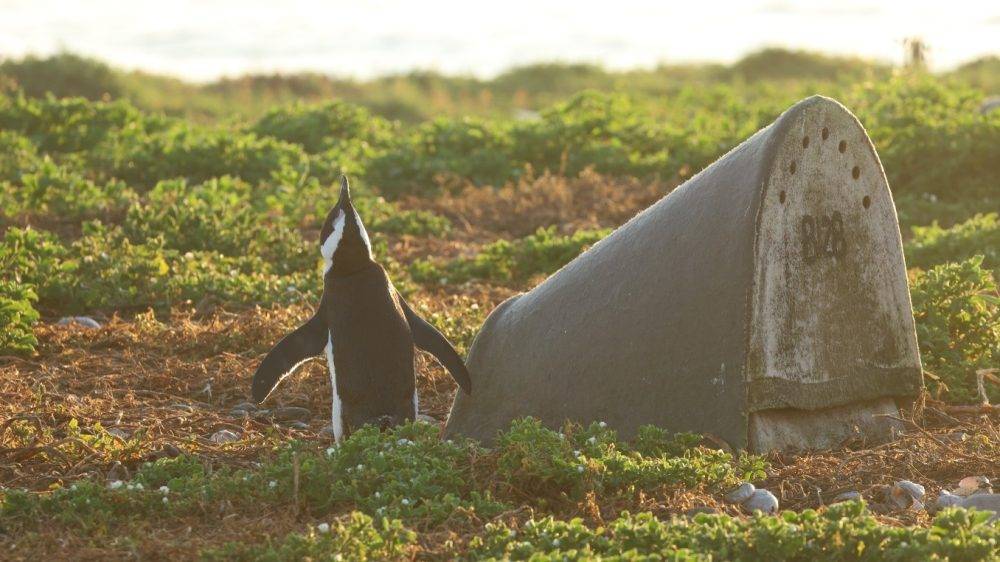Artificial nests increased African penguin breeding rates by 16.5%, though there is no one-size-fits-all design for them. (Supplied)
Artificial nests can increase the breeding rates of endangered African penguins, a new study led by Nelson Mandela University has shown.
These artificial nests — made from wooden boxes, cement and fibreglass — out-performed natural nests and increased breeding output by 16.5%, the international team of researchers from South Africa and the UK found.
Together with her researchers, Lorien Pichegru, the study’s lead author and an adjunct professor at the university’s Institute for Coastal and Marine Research, monitored the breeding success of African penguins at colonies in South Africa for 12 years.
Their findings, which were published in the journal Ecological Solutions and Evidence, cautioned that there was no one-size-fits-all design, with different designs effective at different colonies.
“For example, fibreglass nests had the poorest hatching success of all nest types at one colony (Bird Island), but outperformed cement nests at another (Boulders Beach).”
They were hoping the latest design — the double-layered ceramic nests — would be the “key answer” and would work well at all the colonies but Pichegru said “it wasn’t quite the case”.
The most effective designs of artificial nests were colony-specific, as different colonies face different threats, she said.
“Penguins at land colonies, such as Boulders Beach, face threats from mammals, whereas penguins at colonies devoid of vegetation, such as Bird Island, face sun exposure. Different artificial nest designs were more suited to responding to different threats,” she said.
“Instead of going with only one design, we still have to look for the best one for each colony,” she said.
African penguins, endemic to Southern Africa, are one of the most threatened seabird species globally and they face the risk of extinction in the wild by 2035. Populations have shrunk by 90% in the past 70 years, dwindling to about 8 500 breeding pairs today.
The continued decline in African penguin numbers means that further conservation action is needed beyond artificial nests, primarily through increasing food availability.
“The main causes of the recent decline in African penguin numbers are poor food availability, oil spills, underwater noise pollution and predation,” Pichegru said.
“Biologically meaningful fishing exclusion zones around their major colonies are urgently needed.”
Artificial nests have been used at various colonies in South Africa for more than 30 years.
The study was part of the review of the African Penguin Biodiversity Management Plan (BMP), which was published in 2013 and guides conservation strategies to prevent the extinction of African penguins. It called for new nest designs to maximise breeding output.
“We had 10 years of the BMP being implemented so I’ve been reviewing the conservation actions that worked and the ones that may have worked not as well or could have done better,” Pichegru said. “And, then eventually I got hold of all the data of all the artificial nests and all the natural nests being available for the past 12 years in the eight [largest penguin] colonies.”
This is what made the study exciting. “Before that, we looked at artificial nests, but often within one colony, so I looked at them at Bird Island, some others looked at them at Robben Island, so now we looked at all the colonies at all the same time.”
 African penguins, endemic to Southern Africa, are one of the most threatened seabird species globally and they face the risk of extinction in the wild by 2035. Populations have shrunk by 90% in the past 70 years, dwindling to about 8 500 breeding pairs today.
African penguins, endemic to Southern Africa, are one of the most threatened seabird species globally and they face the risk of extinction in the wild by 2035. Populations have shrunk by 90% in the past 70 years, dwindling to about 8 500 breeding pairs today.
The researchers checked both natural nests and the four types of artificial nests weekly from when eggs were laid until chick fledgling or nest failure. The artificial nests included the newly designed ceramic nests, which have slanted roofs and a 5cm air gap between layers; A-framed pine plywood nests (the oldest design); cement nests made of a mixture of fibreglass and cement and fibreglass burrows which mimic the shape of natural penguin burrows.
They noted that breeding success in natural nests could have been slightly underestimated in the study because of the logistical difficulties of monitoring them. Natural nests monitored for breeding success are often chosen in accessible areas to reduce disturbance and therefore can be more exposed to weather and predators.
“We also weren’t always able to follow the fate of individual birds or breeding pairs closely over multiple years in this study,” said Richard Sherley, a co-author from the University of Exeter.
“That means we can’t be certain how much of the benefit we measured comes from the ‘best’ penguins actively choosing to breed in artificial nests. It would also help conservation strategy if we could understand what makes an artificial nest attractive to penguins or not.”
On the importance of the findings, Pichegru said. “We need to do everything we can to save penguins, so [artificial nests] was a very important conservation action and we needed to see, scientifically, if they worked.”